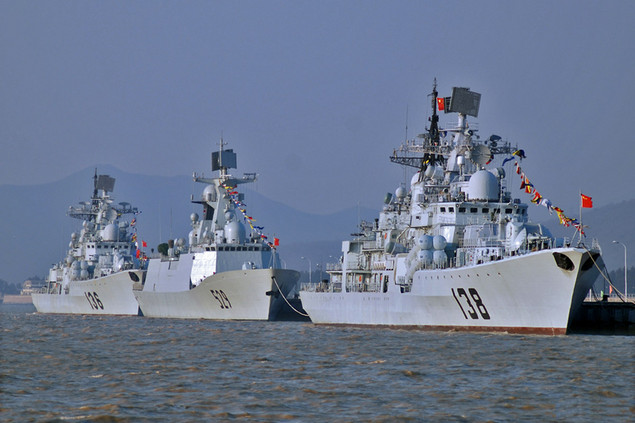 |
| PLAN Warships ( Image credits- Wikimedia Commons) |
Source- The Diplomat
Author- Prashanth Parameswaran
Much has been written about China’s ongoing efforts to become what President Xi Jinping called a “great maritime power” and how the United States should respond. In light of this, it is useful to think about the future trajectory of the of the increasingly modern and powerful People’s Liberation Army Navy (PLAN), which has been charged with both defending China’s sovereignty in ‘near seas’ (eg. Taiwan) and protecting Chinese interests in the ‘far seas’.
Rear Admiral Michael McDevitt, now a senior fellow at the Center for Naval Analyses (CNA), has attempted to do exactly that. In a recent paper delivered at a two-day CNA conference on Chinese maritime power, seen by The Diplomat, McDevitt projects what China’s ‘far seas’ navy will look like in 2020 and how it would rank alongside the United States and other players – Britain, France, Japan, India and Russia. Getting a sense of the PLAN’s ‘far seas’ capabilities is important since it tells us the extent to which it might be able to project power further from China’s shores.
McDevitt’s results, though not entirely surprising, are nonetheless quite striking. According to his projections, on paper by 2020 China’s navy will already increasingly look like a smaller version of the U.S. Navy and will be “the second most capable ‘far seas’ navy in the world.” In five years, the PLAN’s capabilities would dwarf most other navies – China would have as many aircraft carriers as Britain and India, more nuclear attack submarines than either Britain or France, and as many AEGIS-like destroyers as all the other non-US navies combined. China would have two aircraft carriers, 20-22 AEGIS like destroyers and 6-7 nuclear attack submarines, while United States would have eleven aircraft carriers; 88 AEGIS like destroyers; and 48 nuclear attack submarines.
While China would still be far behind the U.S. Navy, its growing capabilities could already begin to have significant implications for the United States and other actors in five years, McDevitt argues. He paints a rather grim picture. By 2020, seeing Chinese warships in the far reaches of the Indian Ocean and the Meditteranean would become a much more routine affair, and some U.S. allies and partners may grow increasingly nervous. It would also become more challenging for the U.S. Navy to keep track of far seas deployed PLAN submarines, while U.S. sea control off of the Middle Eastern and East African hot spots can no longer be assumed. Most alarmingly, McDevitt notes that the image of a Chinese ‘global’ navy will attenuate perception of U.S. power.
The key qualifier, of course, is on paper, a point that McDevitt himself clearly acknowledges. Perhaps most obviously, looking purely at quantity hides the significant qualitative differences that exist between U.S. and Chinese equipment. Rising numbers also tell us little about how operationally competent PLAN far seas forces will be. These include lingering questions about the reliability of combat systems, the training of its sailors, and the functionality of the command structure. Furthermore, straight-line projections cannot reflect the domestic constraints China many face in the coming years that could alter the trajectory of its naval development, including an economic slowdown. Asked how China might confront these challenges, McDevitt said he expected the country to “muddle through,” but that China also did not need to “breathe too hard” to come close to the numbers he projected.
Furthermore, in many ways the United States is still well-positioned to counter threats that a more modern, capable PLAN may pose. As McDevitt noted during the conference, submarines, for instance, continue to remain a distinct American asymmetric advantage. Even here, though, he warned that numbers still do count, a point that former Admiral Gary Roughead also emphasized in his keynote address to the conference on Tuesday (See: “Beware China’s ‘Basing Strategy: Former US Naval Chief”). “We need as many subs as we need to make sure that the Chinese worry about that a lot,” McDevitt said.
About the author- Prashanth Parameswaran is Associate Editor at The Diplomat based in Washington, D.C., where he writes mostly on Southeast Asia, Asian security affairs and U.S. foreign policy in the Asia-Pacific. He is also a PhD candidate at the Fletcher School of Law and Diplomacy at Tufts University. Prashanth previously worked on Asian affairs at the Center for Strategic and International Studies and the Project 2049 Institute. He has also conducted extensive field research in the region and consulted for companies and governments. His writings have appeared in a wide range of publications in the United States and in Asia, including Foreign Policy, The National Interest, The Washington Quarterly, The Straits Times, and The Nation.
To read the original article @ The Diplomat, click here

Comments